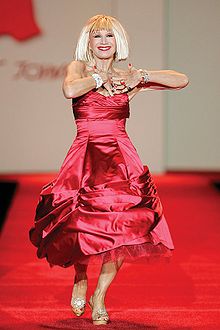1942 - Today
By:
Aleisann Wolliaston
|
Date Added:
Edited

In 1964, Betsey Johnson was a twenty-two-year-old magazine editor, working in the fabrics department of Mademoiselle. She had landed at the magazine by winning its summer scholarship contest, a program that placed promising young ladies in “guest editor” roles while housing them at the Barbizon, an all-female boarding house on East 63rd Street. (Past alumna of the program included Sylvia Plath and Joan Didion.) Though most guest editors spent just one season at the magazine, Johnson had stayed on to fill a spot vacated by a woman on maternity leave. With a full-time job, she decided that it was time to leave the strict environment of the Barbizon, where pants were forbidden and some residents had a designated chaperone. She moved to another all-women’s hotel, but was soon kicked out for smoking in her room. So she found a fifth-floor walkup underneath the Brooklyn Bridge, and, to make rent, began supplementing her magazine income by designing women’s tops. Johnson had studied art at the Pratt Institute, before transferring to Syracuse University to study fabric design. (She’d wanted to finish school somewhere where she could be a cheerleader.) Now she found a hand-crocheted fabric and stitched it “into sweaters that hugged the body,” she writes in her new memoir, “Betsey,” which was published last month by Viking Books. (It’s co-written by her former receptionist and longtime confidant Mark Vitulano.) “They had short, tight sleeves and a scoop neck that was trimmed with a half-inch of velvet. I finished them off with a little bow on the front. They were adorable, if I do say so myself.” Johnson wore one of her own creations to work, and, after her colleagues asked her where they could buy one, she started taking orders, at twenty dollars a piece. “I made a poster with an illustration of a girl wearing the sweater and hung it up in the ladies room at the magazine,” she writes. “Well, that did it.” The demand became so high internally that the Mademoiselle editors put a picture of a model sporting a Johnson sweater in themagazine’s “Shop Here” section. When the actress Kim Novak wrote requesting to buy one, Johnson tucked a handwritten note into the box, signed “XOX, Betsey.In fact, it was the editor Edie Locke, Johnson’s mentor at Mademoiselle, who helped her land the first job that put her in contact with the world of rock stars. Paul Young, an entrepreneur from London, was launching a new store on Madison Avenue called Paraphernalia, and was looking for unknown designers to feature. Young’s taste was forged on Carnaby Street—the mod miniskirts and latex go-go boots of the swinging British youth—and he was looking for American designers to channel the same sensibility. He gave Johnson a tiny workroom, which she shared with a “beautiful hippy-dippy Greek” pattern-maker named Tulah, and encouraged her to make whatever she wanted. Because Johnson’s job at Mademoiselle had been to source interesting fabrics, she started there. She bought lamé fishnet and made a shift dress that she called the Silverfish. She bought faux suede and made, she wrote, “something I called my ‘Story of O’ dress. It was a little A-line with large, strategically placed brass grommets sewn into it, exposing your skin.” (One advertisement asked, “Can you bear the strange din of your Betsey Johnson noise dress?”) Paraphernalia became an uptown hub for downtown musicians and artists. Andy Warhol shopped there, as did Twiggy, Nico, Edie Sedgwick, and Patti Smith. Johnson met the members of the Velvet Underground, who were patrons of the store, and began a breakneck romance with John Cale; they married in 1968, the same year that Cale left the group, and divorced not long after.
click hereShare your thoughts on this story with us. Your comments will not be made public.
Email
Copyright ©2016 - Design By Bureau Blank